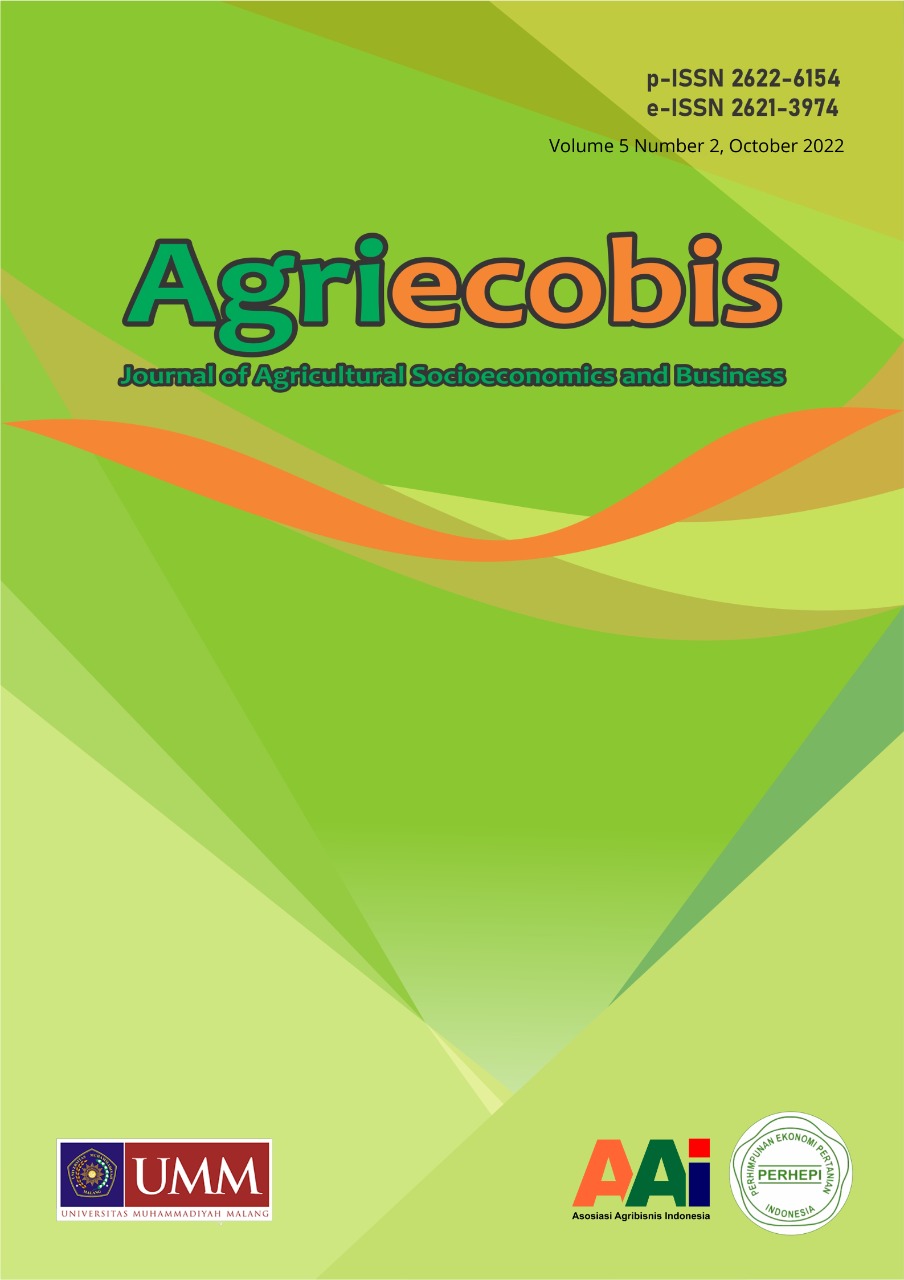Analysis of Soybean Consumption in Indonesia
DOI:
https://doi.org/10.22219/agriecobis.v5i02.16102Keywords:
Regression Analysis , Soybean, Soybean Consumption, Trend AnalysisAbstract
Soybean is one of the main food commodities after rice and corn. Indonesian people indicate that soy consumption will continue to increase yearly along with population, per capita income, and public awareness of food nutrition. Increased demand for soybeans can be linked to an increase in public consumption. The objectives of this study were 1) to analyze the development of soybean consumption in Indonesia and 2) to analyze the factors that influence soybean consumption in Indonesia. This type of research is descriptive with a quantitative approach. The type of data used is secondary data (time series). The analysis method used in this research is Trend Analysis with Moving Average and Multiple Linear Regression Analysis. The variables used are soybean price (X1), substitution price (peanuts) (X2), income per capita (X3), and soybean consumption (Y). The study's results using the trend test showed that the value forecast of soybean consumption for the next or future period was 0.29, where the MAD value was 0.01, the MSE value was 0, and the MAPE value was 0.04. The multiple linear regression test showed that the price of soybeans and income per capita had a significant effect on soybean consumption. In contrast, the substitution price had no significant effect on soybean consumption.
Downloads
References
Abbas, I. (2016). Penerapan Metode Moving Average (MA) Berbasis Algoritma Support Vector Machine (SVM) untuk Membandingkan Pola Kurva dengan Trend Kurva pada Trading Forex Online. Jurnal Ilmiah ILKOM, 8(1), 37–43. https://doi.org/10.33096/ilkom.v8i1.20.37-43
Aldillah, R. (2015). Proyeksi Produksi dan Konsumsi Kedelai Indonesia. Jurnal Ekonomi Kuantitatif, 8(1), 9–23.
Anjani, S. R., Darwanto, D. H., & Mulyo, J. H. (2015). Analisis Permintaan Kedelai di Indonesia. Sepa, 12(1), 42–47.
Hakimah, M., Muhima, R. R., & Yustina, A. (2015). Rancang Bangun Aplikasi Persediaan Barang dengan Metode Trend Projection. SimanteC, 5(1).
Junianto, R., Patiung, M., & Koesriwulandari. (2019). Analisis Trend Penawaran dan Permintaan Komoditi Kedelai Indonesia. Jurnal Ilmiah Sosio Agribis, 19(2), 45–63. https://doi.org/10.30742/jisa.v19i2.830
Komalasari, W. B. (2008). Prediksi Penawaran dan Permintaan Kedelai dengan Analisis Deret Waktu. Informatika Pertanian, 17(2), 1195–1209.
Mahdoh, & Risyanto, H. (2018). Analisis Pengaruh Konsumsi Kedelai, Produksi Kedelai dan Cadangan Devisa Terhadap Impor Kedelai di Indonesia. I-Economic, 4(2), 180–193. https://doi.org/10.19109/ieconomics.v4i2.2736
Muryati. (2017). Analisis Peramalan Penjualan Usaha Ardyla Bakery di Muara Bulian. Jurnal Ilmiah Universitas Batanghari Jambi, 17(3), 259–269.
Nainggolan, K. U., Agung, I. D. G., & Tenaya, I. M. N. (2016). Pengaruh Produksi, Konsumsi, dan Harga Kedelai Nasional Terhadap Impor Kedelai di Indonesia Periode 1980 Sampai dengan 2013. E-Journal Agribisnis Dan Agrowisata, 5(4), 742–751.
Paruntu, S. A., & Palandeng, I. D. (2018). Analisis Ramalan Penjualan dan Persediaan Produk Sepeda Motor Suzuki Pada Pt Sinar Galesong Mandiri Malalayang. Jurnal EMBA, 6(4), 2828–2837. https://doi.org/10.35794/emba.v6i4.21067
Permadi, G. S. (2015). Analisis Permintaan Impor Kedelai Indonesia. Eko-Regional, 10(1).
Riana, F. D., & Hardiyanto, I. (2011). Analisis Peramalan Konsumsi Kedelai (Glycine max L.) Di Indonesia Tahun 2010-2019. AGRISE, XI(1), 1–7.
Riniarsi, D. (2015). Outlook Komoditas Pertanian Subsektor Tanaman Pangan Kedelai (Tarmat & V. S. B. H. (eds.)). Pusat Data dan Sistem Informasi Pertanian Kementerian Pertanian.
Sagala, I. M., Suryadi, & Adhiana. (2020). Analisis Faktor-Faktor yang Mempengaruhi Permintaan Kedelai di Provinsi Sumatera Utara. Jurnal Penelitian Agrisamudra, 7(1), 1–13. https://doi.org/10.33059/jpas.v7i1.2197
Sari, P. M. (2015). Analisis Faktor-Faktor yang Mempengaruhi Konsumsi Kedelai di Indonesia. Journal of Economic and Economic Education, 4(1), hal. 30-41.
Sari, P. M., Aimon, H., & Syofyan, E. (2014). Analisis Faktor-Faktor yang Mempengaruhi Produksi, Konsumsi, dan Impor Kedelai di Indonesia. Jurnal Kajian Ekonomi, III(5).
Waliyansyah, R. R. (2020). Identifikasi Jenis Kedelai (Glycine Max L) Menggunakan Gray Level Coocurance Matrix (CLCM) dan K-Means Clustering. Jurnal Teknologi Informasi dan Ilmu Komputer (JTIIK), 7(1).
Wibowo, K. C., Putri, D. S., & Hidayati, S. (2020). Analisis Peramalan Produksi dan Konsumsi Daging Ayang Ras Pedaging di Indonesia Dalam Rangka Mewujudkan Ketahanan Pangan. Majalah Teknologi Agro Industri (Tegi), 12(2), 58–65.
Downloads
Published
How to Cite
Issue
Section
License
Copyright (c) 2022 Agriecobis : Journal of Agricultural Socioeconomics and Business

This work is licensed under a Creative Commons Attribution-ShareAlike 4.0 International License.
Authors who publish with Agriecobis : Journal of Agricultural Socioeconomics and Business agree to the following terms:
- For all articles published in Agriecobis : Journal of Agricultural Socioeconomics and Business, copyright is retained by the authors. Authors give permission to the publisher to announce the work with conditions. When the manuscript is accepted for publication, the authors agree to automatic transfer of the publishing right to the publisher.
- Authors retain copyright and grant the journal right of first publication with the work simultaneously licensed under a Creative Commons Attribution-ShareAlike 4.0 International License that allows others to share the work with an acknowledgment of the work's authorship and initial publication in this journal.
- Authors are able to enter into separate, additional contractual arrangements for the non-exclusive distribution of the journal's published version of the work (e.g., post it to an institutional repository or publish it in a book), with an acknowledgment of its initial publication in this journal.
- Authors are permitted and encouraged to post their work online (e.g., in institutional repositories or on their website) prior to and during the submission process, as it can lead to productive exchanges, as well as earlier and greater citation of published wor (See The Effect of Open Access).

This work is licensed under a Creative Commons Attribution-ShareAlike 4.0 International License.







